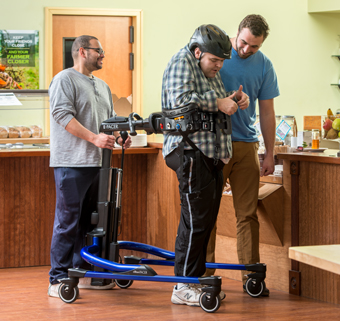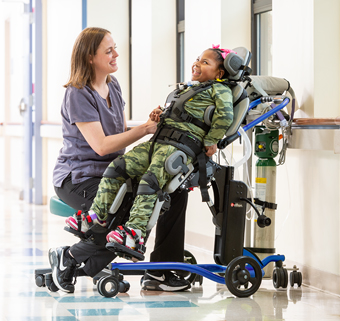Dynamic Seating and Pelvic Positioning
| May 2013The human body is designed to move. Movement is vital in keeping the body’s systems healthy and functioning. Without movement, function is lost, muscles weaken and skin is at risk of breaking down. Conditions such as cerebral palsy may limit an individual’s ability to initiate purposeful, spontaneous movement and so impede muscle strengthening and growth. Such people must be presented with maximum opportunities for purposeful movement. Because people with physical disabilities tend to be sedentary much of the day, as caregivers we need to look for seating that allows for movement.
Until recently, seating systems for people with disabilities have been fixed and static. Reclined wheelchairs and support systems often foster a reclined and relaxed body position. Adjustments are difficult to make and may require special tools. The chair is custom-fitted to the client once by a specialist then used for many years. These constraints can unintentionally limit purposeful movement.
Certainly, addressing the seating needs of an individual with a disability is complex: their movement quantity, quality and control must be taken into account and matched to a seating system that can offer the supports appropriate to their needs. But more than that, adaptive seating must allow for motor growth by positioning the client for movement. Especially for children with disabilities in a classroom setting, sitting should be an active and learning experience.
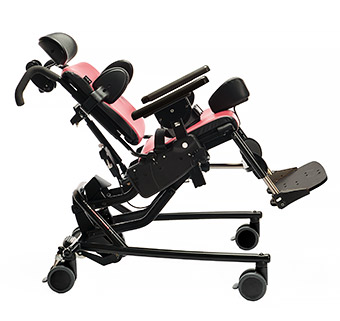 A previous article on this blog discussed
active sitting for task participation,
describing how positioning a child in the
classroom chair
can positively affect the child’s ability to function and to move. A more universal term for active sitting is “dynamic seating,” a concept that is rapidly gaining currency among adaptive seating experts. The goal of
dynamic seating
is to use the “energy” of a seating system to channel the fluctuating muscle tone, spasticity or hypotonia of an individual with physical challenges into purposeful movements.
A previous article on this blog discussed
active sitting for task participation,
describing how positioning a child in the
classroom chair
can positively affect the child’s ability to function and to move. A more universal term for active sitting is “dynamic seating,” a concept that is rapidly gaining currency among adaptive seating experts. The goal of
dynamic seating
is to use the “energy” of a seating system to channel the fluctuating muscle tone, spasticity or hypotonia of an individual with physical challenges into purposeful movements.
So how do we go about creating an environment in which seating encourages meaningful movement? There are currently two approaches:
- The seating system has a built-in ability to move to accommodate the movements of the client and then return to neutral. The full seating and positioning system may be able to move, or movement may be restricted to certain parts of the chair (e.g., dynamic back canes on a wheelchair or dynamic back springs on a Rifton Activity Chair).
- The features and components of a seating system are adjusted to allow a child to functionally move within the system and receive sensory feedback about movement quality (e.g., adjusting the seat angle or using pelvic supports).
With either approach, controlling the pelvis is perhaps the most fundamental step in accomplishing successful dynamic sitting. The pelvis is the anchor from which the trunk muscles contract and stabilize. This in turn allows muscle control of the upper extremities and head movements. In typical individuals, pelvic stabilization is accomplished by synergistically contracting lumbar and abdominal muscles with input from hip musculature, but for individuals with tone and postural control issues, additional prompting is necessary for the best functional outcomes.1-5
Pelvic stabilization can be accomplished in different ways but ideally, the pelvis is kept back in the seat with allowance for pelvic tilt and adjustments to achieve active sitting postures.6 A properly controlled pelvis will prevent sacral sitting and improve lumbar muscle recruitment and symmetrical posturing.7-9
A seating system with built-in dynamic features may be of greatest benefit to individuals with extensor tone. When in extension, their body’s force is directed against the backrest. In a static seating system, this force is not absorbed because the backrest has no “give.” Instead, it acts upon the individual’s position. The pelvis is pushed forward into posterior tilt and this moves on up the spine resulting in kyphotic posturing that only gets worse with each thrusting episode.7 In a dynamic system, when the user extends, the seat-to-back angle of the chair opens up simultaneously with the hip angle. On relaxation, the chair returns to a neutral position and the pelvis follows the line of the chair and drops back into place.7
Using this type of seating, a study by Hahn and colleagues showed trends of improved muscle tone, range of motion, self-care, mobility, and social skills in children with cerebral palsy.10 Similarly, Cimolin et al. found that a built-in dynamic component improved range of motion of the trunk and decreased dystonia and dyskinesia in children with dystonic tetraparesis.7 These findings provide a direction for future use and studies of dynamic seating.
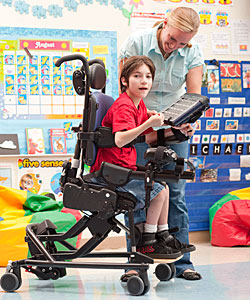 As mentioned above, dynamic seating can also be achieved by using the chair’s
positioning prompts and features
to encourage active sitting. The key is to provide optimal positioning with as few supports as possible so a client is not passively restrained by the chair but rather can challenge their boundaries of stability. This will ultimately result in improved muscle strength, balance, and postural awareness. Most seating and positioning systems come with laterals, chest supports, abductors and leg prompts. All of these can be used to achieve “optimal” active positioning.
As mentioned above, dynamic seating can also be achieved by using the chair’s
positioning prompts and features
to encourage active sitting. The key is to provide optimal positioning with as few supports as possible so a client is not passively restrained by the chair but rather can challenge their boundaries of stability. This will ultimately result in improved muscle strength, balance, and postural awareness. Most seating and positioning systems come with laterals, chest supports, abductors and leg prompts. All of these can be used to achieve “optimal” active positioning.
One of the most valuable features of an adaptive chair is the seat-to-back angle adjustment because this can help facilitate pelvic stability, postural control, and improve upper-extremity function. The Rifton Activity Chair is a good example. For individuals with extensor tone, moving the backrest anteriorly to close the hip angle, and simultaneously closing the knee angle by moving the footrest posteriorly helps control tone and pelvic thrusting.11
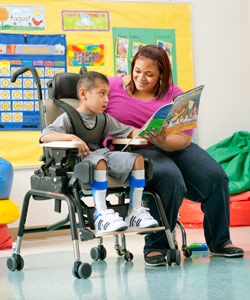 Alternatively, a client with low tone responds to a neutral or slightly anterior backrest with the footboard positioned level or anteriorly to encourage increased muscle activation and extension. An adjustable footboard can help with stability, weight-bearing and sensory feedback of the lower extremities. Clients with poor postural control may benefit from opening the angle of the hips by adjusting the backrest posteriorly and using the tilt-in-space feature to create an anterior seat angle. This helps reduce kyphotic posturing and improves head control.11
Alternatively, a client with low tone responds to a neutral or slightly anterior backrest with the footboard positioned level or anteriorly to encourage increased muscle activation and extension. An adjustable footboard can help with stability, weight-bearing and sensory feedback of the lower extremities. Clients with poor postural control may benefit from opening the angle of the hips by adjusting the backrest posteriorly and using the tilt-in-space feature to create an anterior seat angle. This helps reduce kyphotic posturing and improves head control.11
The need for dynamic seating is becoming more widely recognized, and we need to encourage this trend. People with physical disabilities are so often limited in their movement, and dynamic seating can help reverse the immobility created by static seating. Beyond providing stable and active seating postures, dynamic seating opportunities give individuals—especially children—a means to move purposefully, gain postural control and improved function, and participate in their surroundings and wider communities.
References
1. Saavedra S, Woollacott M, van Donkelaar P. Head stability during quiet sitting in children with cerebral palsy: effect of vision and trunk support. Exp Brain Res. 2010; 201: 13-23.
2. Cheng HY, Lien YJ, Yu YC, et al. The effect of lower body stabilization and different writing tools on writing biomechanics in children with cerebral palsy. Res Dev Disabil. 2013; 34(4): 1152-9.
3. Van der Heide JC, Fock JM, Otten B, et al. Kinematic characteristics of postural control during reaching in preterm children with cerebral palsy. Pediatric Research. 2005; 58(3): 586-93.
4. Lacoste M, Therrien M, Prince F. Stability of children with cerebral palsy in their wheelchair seating: perceptions of parents and therapists. Disabil Rehabil Assist Technol. 2009; 4(3): 143-50.
5. West JF. The importance of postural control for feeding. Pediatric Nursing. 2004; 30(2): 97-100.
6. Reid DT, Rigby P. Development of improved anterior pelvic stabilization devices for children with cerebral palsy. Phys Occup Ther Pediatr. 1996; 16(3): 91-6.
7. Cimolin V, Piccinini L, Avellis M, et al. 3D-quantitative evaluation of a rigid seating system and dynamic seating system using 3D movement analysis in individuals with dystonic tetraparesis. Disabil Rehabil Assist Technol. 2009; 4(6): 422-28.
8. Smith D, Bissell G, Bruce-Low S, et al. The effect of lumbar extension training with and without pelvic stabilization on lumbar strength and low back pain. J Back Musculoskelet Rehabil. 2011; 24: 241-49.
9. San Juan JG, Yaggie JA, Levy SS, et al. Effects of pelvic stabilization on lumbar muscle activity during dynamic exercise. J Strength Cond Res. 2005; 19(4): 903-7.
10. Hahn ME, Simkins SL, Gardner JK. A dynamic seating system for children with cerebral palsy. J Musculoskelet Res. 2009; 12(1): 21-30.
11. Paleg G. Dynamic Seating Webinar. 2011. Accessed June 2025. https://www.rifton.com/education-center/videos/dynamic-seating-webinar

